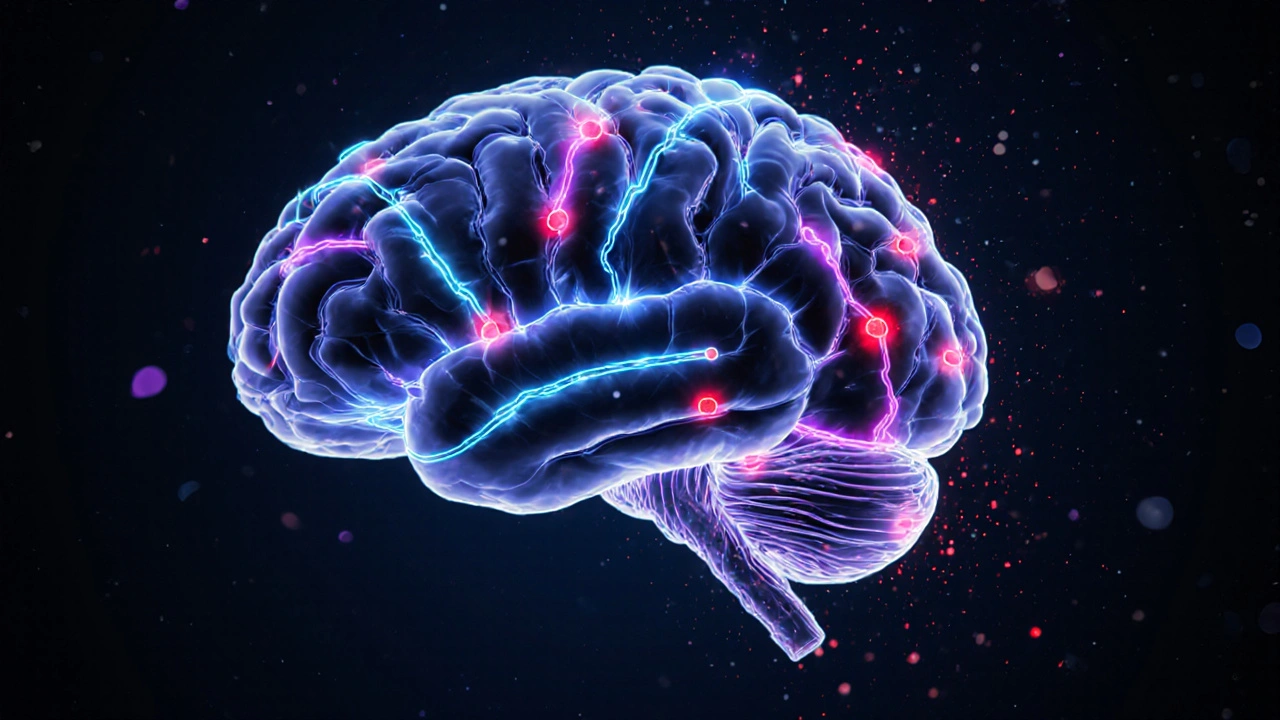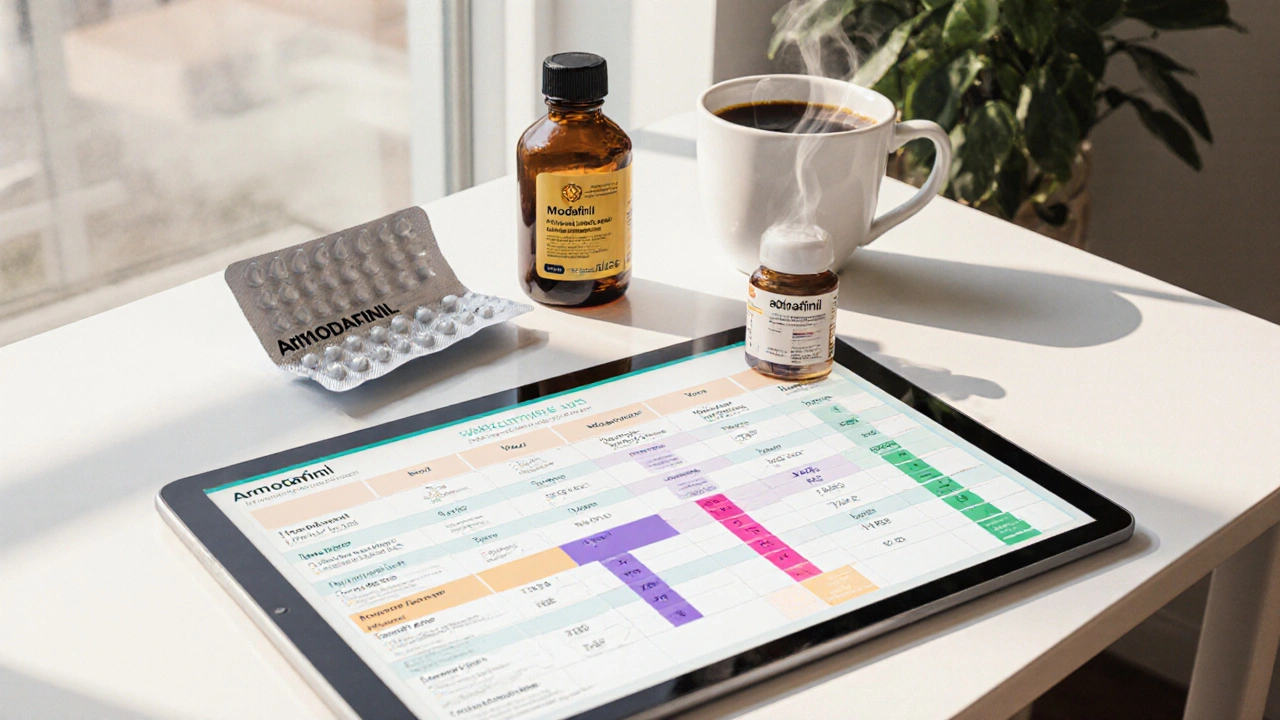Wake-Promoting Agent Comparison Tool
Agent Details
Select an agent to see detailed information.
Comparison Table
| Agent | Duration | Cost (Monthly) | Side Effects | Prescription Required |
|---|
Quick Summary
- Armodafinil provides the longest half‑life among popular wake‑promoting agents.
- Modafinil is cheaper and has a similar efficacy profile.
- Adrafinil works like a pro‑drug for modafinil but can stress the liver.
- Caffeine is the most accessible, but its effect peaks fast and tapers quickly.
- Prescription stimulants (methylphenidate, amphetamine) are stronger but carry higher abuse risk.
When you search for a wake‑fulness aid, Armodafinil often tops the list. Below we break down how it stacks up against the most mentioned alternatives, so you can decide which option fits your schedule, health profile, and budget.
What is Armodafinil a prescription medication that promotes wakefulness?
Armodafinil (brand name Nuvigil) was approved by the FDA U.S. Food and Drug Administration, the agency that regulates prescription drugs in 2007 for narcolepsy, shift‑work sleep disorder, and obstructive sleep apnea. Chemically it is the R‑enantiomer of modafinil, meaning it’s a single‑molecule version that delivers a steadier plasma concentration.
How does Armodafinil work?
The exact mechanism isn’t fully mapped, but research shows it boosts dopamine signaling by inhibiting reuptake, while also nudging orexin (hypocretin) neurons awake. This cocktail raises alertness without the jittery buzz typical of classic stimulants.
Key criteria for comparing wake‑promoting agents
- Efficacy: How reliably does the drug increase wakefulness?
- Duration of action: How long does the effect last?
- Onset: Minutes until you feel a difference.
- Side‑effect profile: Frequency of headaches, anxiety, insomnia, liver impact, etc.
- Legal status & prescription requirement: Over‑the‑counter vs prescription only.
- Cost: Typical out‑of‑pocket price in the United States (USD) and Australia (AUD).

Comparison table
| Agent | Mechanism | Typical Dose | Half‑life | Cost (US$ per month) | Prescription? | Common Side Effects |
|---|---|---|---|---|---|---|
| Armodafinil | Dopamine reuptake inhibition, orexin activation | 150mg once daily | 15h | 150‑200 | Yes | Headache, nausea, insomnia |
| Modafinil | Same as armodafinil (racemic mixture) | 200mg once daily | 12‑15h | 100‑150 | Yes | Dry mouth, dizziness, anxiety |
| Adrafinil | Pro‑drug converted to modafinil in liver | 300‑600mg in morning | 10‑12h (active metabolite) | 30‑60 (over‑the‑counter) | No | Liver enzyme elevation, fatigue after use |
| Caffeine | Adenosine receptor antagonist | 100‑200mg (1‑2 cups coffee) | 5‑6h | ~0 (household) | No | Jitters, increased heart rate, withdrawal headache |
| Methylphenidate | Dopamine‑norepinephrine reuptake inhibitor | 10‑30mg 1‑3×/day | 3‑4h | 80‑120 | Yes | Appetite loss, insomnia, cardiovascular strain |
| Amphetamine | Promotes release of dopamine & norepinephrine | 5‑30mg 1‑2×/day | 9‑12h | 90‑130 | Yes | Elevated blood pressure, dependence risk, mood swings |
Deep dive into each alternative
Modafinil
Modafinil is the sibling of armodafinil, containing both R‑ and S‑enantiomers. Clinical trials show comparable wake‑promoting power, but many users report a slightly lighter “head‑space” that feels easier to transition into night sleep. It’s often 30‑40% cheaper than armodafinil, making it a popular first‑line choice for budget‑aware patients.
Adrafinil
Originally developed in France, adrafinil bypasses the prescription barrier because it’s sold as a dietary supplement in some countries. The liver converts it to modafinil, which means you get the same benefits after a short lag (about 45‑60 minutes). The trade‑off is a measurable rise in liver enzymes with regular use-especially at doses above 600mg. People with pre‑existing liver conditions should avoid it.
Caffeine
Caffeine is the world’s most common stimulant. Its rapid onset (5‑15 minutes) works well for short‑term focus bursts, like pulling an all‑night study session. However, the effect peaks in 30‑60 minutes and drops off within a few hours, often leading to an energy crash. Tolerance builds quickly, so you need more each day to feel the same lift.
Methylphenidate
Commonly known as Ritalin or Concerta, methylphenidate is a prescription stimulant used for ADHD. It delivers a sharper cognitive edge than modafinil, especially for tasks requiring rapid decision‑making. The downside is a shorter half‑life (3‑4hours) and a higher potential for appetite suppression and cardiovascular strain.
Amphetamine
Amphetamines (Adderall, Dexedrine) act by flooding the brain with dopamine and norepinephrine. They are the most potent wake‑fulness agents on the list and can keep you alert for a full work shift. The power comes with a steep abuse risk, possible mood swings, and a strict scheduling requirement in many countries.
Choosing the right agent for your situation
If you have a diagnosed sleep disorder like narcolepsy, the safest bet is a prescription that’s been vetted for that condition-so armodafinil or modafinil. For occasional night‑owl days, caffeine or adrafinil may be sufficient, but keep an eye on liver health with adrafinil.
People who need a strong, rapid boost for tasks like exam‑day studying often reach for methylphenidate, but only under a doctor’s supervision because of heart‑rate concerns.
When cost is the primary barrier, modafinil typically costs 30‑40% less than armodafinil while delivering near‑identical wakefulness. For those who prefer an over‑the‑counter route, caffeine remains unbeatable in price, but the trade‑off is a shorter window of alertness.
Lastly, consider your personal tolerance to side effects. If headaches are a chronic issue, you might find the lower incidence with armodafinil appealing, as some surveys show a 10% drop compared to modafinil.
Safety, legal, and insurance considerations
In the United States, the FDA classifies armodafinil, modafinil, methylphenidate, and amphetamines as ScheduleIV or ScheduleII substances, meaning they require a prescription and are subject to monitoring. Adrafinil sits in a gray area-legal to sell as a supplement in some regions but banned in the EU.
Insurance plans often cover armodafinil for narcolepsy but not for off‑label cognitive enhancement. Always verify coverage before starting therapy.
If you are pregnant, breastfeeding, or have a history of heart disease, discuss alternatives with a healthcare professional. Stimulants can raise blood pressure and heart rate, which may be risky for certain patients.
Practical tips for optimal use
- Take armodafinil or modafinil early in the morning to avoid nighttime insomnia.
- Pair caffeine with a small protein snack to blunt the crash.
- Rotate between adrafinil and a non‑pharmacologic method (bright‑light therapy) every few weeks to protect liver function.
- If you use prescription stimulants, schedule regular blood pressure checks.
- Maintain a consistent sleep schedule; no drug can fully replace good sleep hygiene.

Frequently Asked Questions
Is armodafinil stronger than modafinil?
Armodafinil contains only the R‑enantiomer, which lasts longer in the bloodstream. In practice the “strength” feels similar, but the duration can be up to two hours longer, making it feel more potent for late‑day shifts.
Can I buy armodafinil online without a prescription?
Legally, no. Most reputable pharmacies require a valid prescription. Websites that claim otherwise often operate outside regulation and may ship counterfeit products.
How does adrafinil affect liver enzymes?
Studies show a modest rise (10‑20%) in ALT and AST after 6‑8 weeks of daily 600mg dosing. People with pre‑existing liver disease should avoid it or get routine liver‑function testing.
Is caffeine a safe long‑term alternative?
For most adults, moderate caffeine (up to 400mg/day) is safe and even linked to lower Parkinson’s risk. However, tolerance builds, and high intake can increase anxiety and disrupt sleep.
Which drug has the lowest risk of dependence?
Armodafinil and modafinil rank lowest for physical dependence, largely because they don’t produce the intense dopamine surge seen with amphetamines. Psychological habit can still develop if used daily without breaks.



7 Comments
Ashley Helton
October 1, 2025 AT 18:38Wow, a whole comparison table for wake‑up pills – because we all need a spreadsheet to decide if we want to feel human today. The sarcasm is real, but kudos for laying out the side‑effects so cleanly; now I can pretend I’m a pharmacist while actually just scrolling Reddit. If you’re a night owl, the longer half‑life of armodafinil might actually keep you up for that 3 am gaming session you claim you don’t have. And hey, at least the cost column tells us which drug will empty my bank account faster than my rent. Friendly reminder: always check with a doctor before you start treating yourself like a lab experiment.
Brian Jones
October 14, 2025 AT 09:02Alright, let’s break this down – first, the mechanism: dopamine reuptake inhibition, orexin activation – all lovely jargon that sounds like a sci‑fi plot twist. Second, duration: armodafinil’s 15‑hour half‑life means you won’t be crashing at 10 pm, unlike caffeine’s fleeting 5‑hour cameo. Third, cost: $150‑200 a month is a small price to pay for staying awake during that 3‑hour Zoom you could have skipped. Fourth, side‑effects – headaches, nausea, insomnia – classic, but remember, you can always blame the coffee. Fifth, prescription: yes, it’s required, because apparently the universe doesn’t trust us with unlimited alertness. Lastly, always consult a professional – they’ll tell you what you already know from reading the fine print!
Carlise Pretorius
October 26, 2025 AT 22:26i think this guide is actually pretty helpful thx for the table. i always wondered why armodafnial is more pricey than modafninil lol. the side effect list is real af i had a hissy fit after a night on caffeine. the liver thing with adrafinil is something i didn’t know, good heads up. btw the cost numbers are kinda crazy but i guess you get what you pay for.
Johnson Elijah
November 8, 2025 AT 12:50🚀🚀 If you’re looking to power through a night shift, armodafinil’s long half‑life is your new best friend! 🌙💪 But remember, every superhero needs a sidekick – stay hydrated, grab a snack, and maybe keep a bottle of water on your desk. ☕️ If caffeine’s your go‑to, just know it’ll wear off faster than a Snapchat story. 😅 And for the heavy‑hit crowd, methylphenidate or amphetamine can crank the engine, but they come with a ‘handle with care’ label. 👍 Stay safe, stay smart, and may your mornings be less… *groggy*.
Roxanne Lemire
November 21, 2025 AT 03:14Side effects matter more than cost.
Patrick Price
December 3, 2025 AT 17:38Wow that one‑sentence drop hit hard, like a caffeine crash after a midnight espresso run, but yeah side effects are the real deal‑breaker.
Travis Evans
December 16, 2025 AT 08:02Okay, let’s talk colorfully – imagine your brain as a neon billboard. Caffeine is that quick flicker of neon pink: bright, brief, and leaves you wanting more. Modafinil? Think deep electric blue, steady, lasts longer, and doesn’t scream for attention. Armodafinil is the ultra‑violet laser that cuts through the night, keeping you laser‑focused without the jittery bounce. Adrafinil is the cheap glow‑stick you found in the back of a drawer – it works, but you’ll notice the sticky residue (hello, liver enzymes). Methylphenidate? That’s the roaring red convertible, fast and furious, but you better have a good driver’s license (aka a doc). Amphetamine? The whole fireworks show – dazzling, powerful, but you’ll need a safety net because it can blow up if you’re not careful. Bottom line: pick the hue that matches your vibe, but always check the safety manual before lighting the fuse.